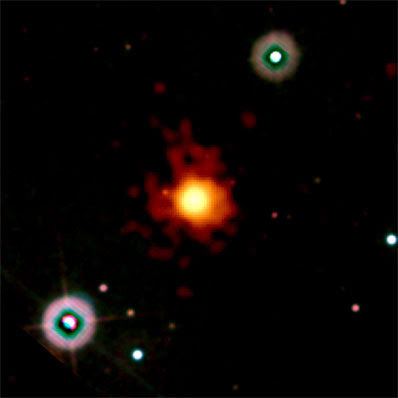Astronomy

- Fermi Solves The Mystery Of Gamma Ray Pulsars
A pulsar is a highly magnetised rapidly spinning neutron star , the dense core remaining aftera supernova explosion.NASA's Fermi Gamma-ray Space Telescope solves the mystery of previously unidentified gamma-ray sources. Fermi has now uncovered 16...
- Fog Lifted On Dark Gamma-ray Bursts Across The Universe
Gamma-ray bursts, with their ability to pierce through gas and dust to shine brightly across the universe, are revealing areas of intense star formation and stellar death where astronomers have been unable to look -- the dusty corners of otherwise dust-free...
- Strongest-ever Gamma Ray Explosion Reorded
Astronomers have disovered the "strongest-ever" gamma ray explosion , exceeding the power of some 9,000 exploding stars, in the deep space constellation Carina. The blast was discovered by Fermi Gamma-ray Space Telescope, a collaboration among NASA, the...
- A New Kind Of Black Hole!
A hybrid gamma-ray burst was been detected by Swift, one of NASA's satellites, on June 14. Scientists think that this explosion has created a black hole, but was not accompanied by a supernova. It is called GRB 060614 and is located in the constellation...
- Unidentified Radio Wave From Space Detected, Are Aliens Beaming Radio Signals Directly At Earth?
The Parkes TelescopeThe Parkes radio telescope in Australia has detected a cosmic radio burst in real time. Within hours of the discovery, 12 different telescopes both on Earth and in space were pointed in the direction of the burst, but none recorded...
Astronomy
Gamma-ray burst smashes cosmic distance record

WASHINGTON -- NASA's Swift satellite and an international team of astronomers have found a gamma-ray burst from a star that died when the universe was only 630 million years old, or less than five percent of its present age. The event, dubbed GRB 090423, is the most distant cosmic explosion ever seen.
At 3:55 a.m. EDT on April 23, Swift detected a ten-second-long gamma-ray burst of modest brightness. It quickly pivoted to bring its ultraviolet/optical and X-ray telescopes to observe the burst location. Swift saw a fading X-ray afterglow but none in visible light.
- Fermi Solves The Mystery Of Gamma Ray Pulsars
A pulsar is a highly magnetised rapidly spinning neutron star , the dense core remaining aftera supernova explosion.NASA's Fermi Gamma-ray Space Telescope solves the mystery of previously unidentified gamma-ray sources. Fermi has now uncovered 16...
- Fog Lifted On Dark Gamma-ray Bursts Across The Universe
Gamma-ray bursts, with their ability to pierce through gas and dust to shine brightly across the universe, are revealing areas of intense star formation and stellar death where astronomers have been unable to look -- the dusty corners of otherwise dust-free...
- Strongest-ever Gamma Ray Explosion Reorded
Astronomers have disovered the "strongest-ever" gamma ray explosion , exceeding the power of some 9,000 exploding stars, in the deep space constellation Carina. The blast was discovered by Fermi Gamma-ray Space Telescope, a collaboration among NASA, the...
- A New Kind Of Black Hole!
A hybrid gamma-ray burst was been detected by Swift, one of NASA's satellites, on June 14. Scientists think that this explosion has created a black hole, but was not accompanied by a supernova. It is called GRB 060614 and is located in the constellation...
- Unidentified Radio Wave From Space Detected, Are Aliens Beaming Radio Signals Directly At Earth?
The Parkes TelescopeThe Parkes radio telescope in Australia has detected a cosmic radio burst in real time. Within hours of the discovery, 12 different telescopes both on Earth and in space were pointed in the direction of the burst, but none recorded...
